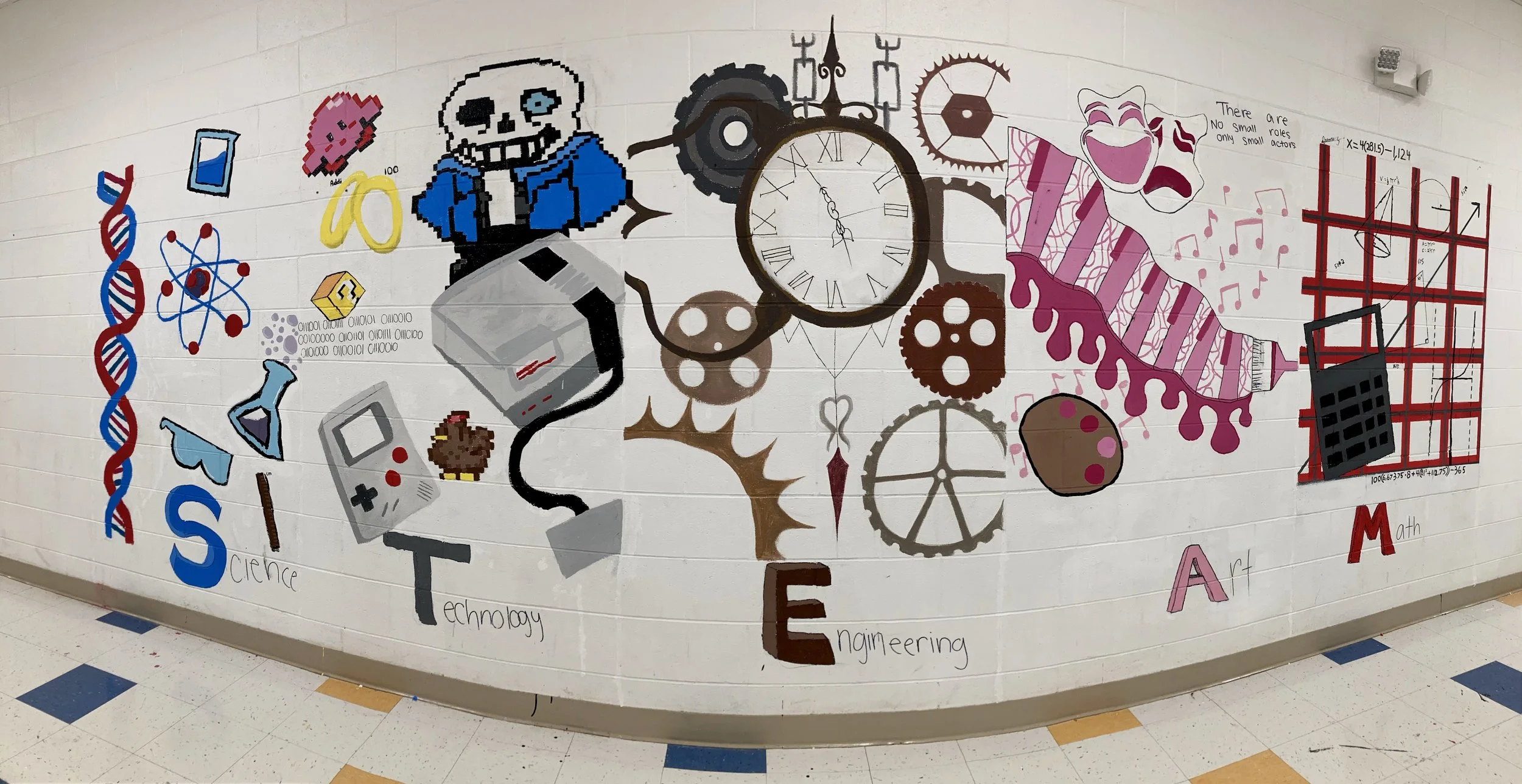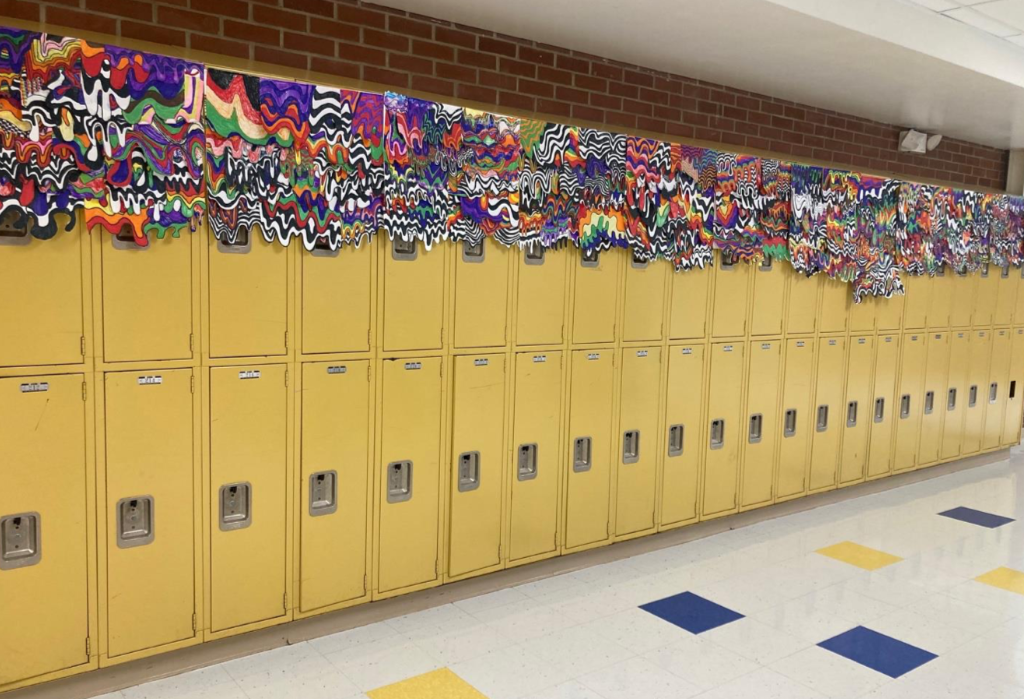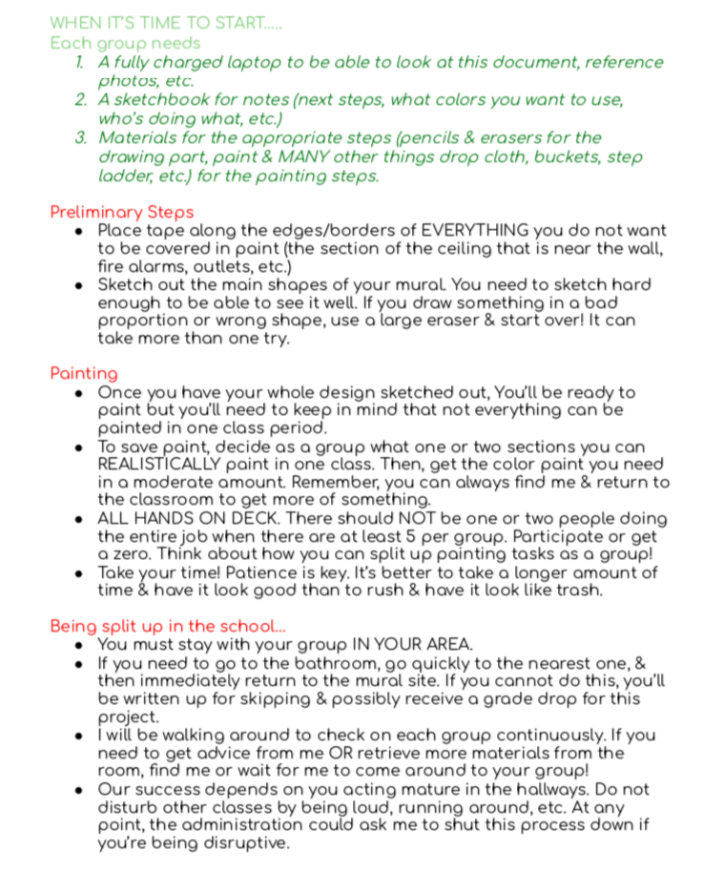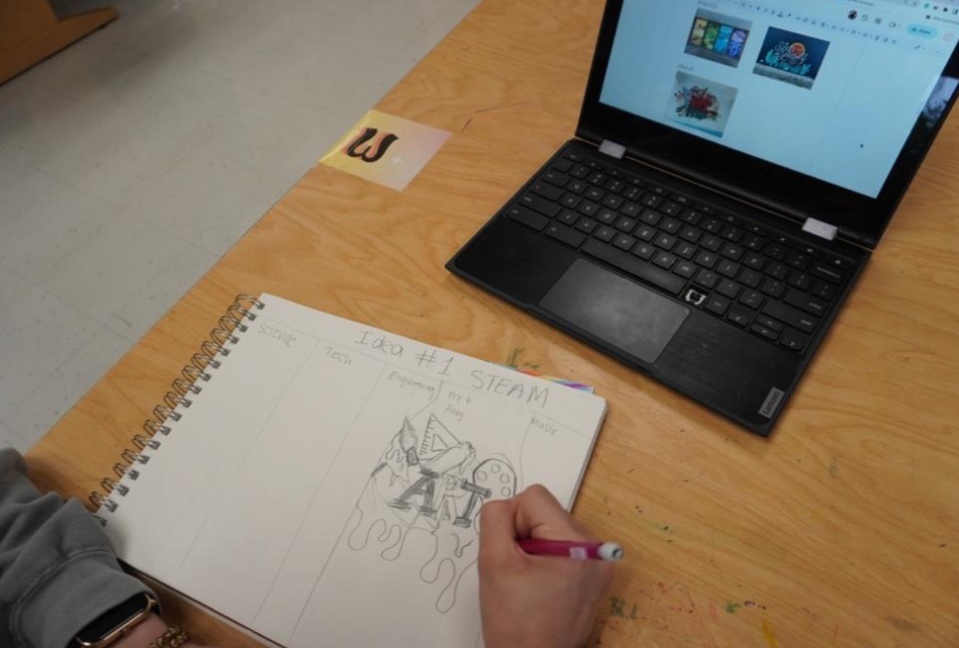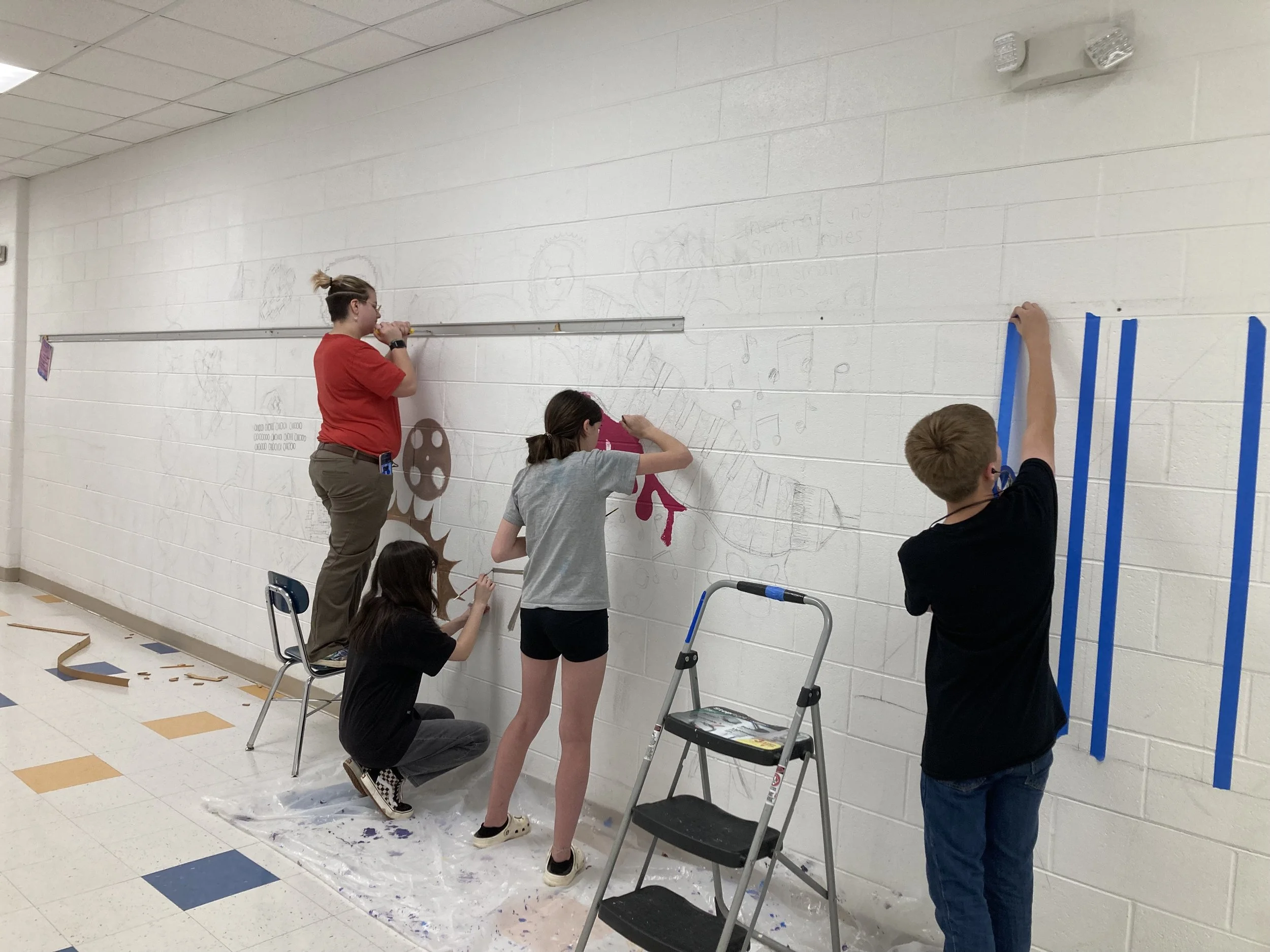Collaborative Murals Project for 8th Grade Students
An overview of the Murals unit I created for 8th grade students to fulfill the requirements for my MFA from University of Florida. This overview features Lesson Plans, Photos, and takeaways that can be adapted for any art educator seeking to bring collaboration, free-choice teaching, and culture into their classrooms.
This capstone project is an inquiry into and evaluation of an 8th-grade art education mural painting curriculum unit for a Title 1 School in the Garner, North Carolina Public School System with the purpose of program development. The unit focused on identity and ownership for underserved students. This research into curriculum building emphasized the themes of collaboration and empathy to foster a sense of community amongst students with the goals of developing identity and inclusion through mural making.
The use of Action Research was used to investigate specific narrative stories of my lived experiences leading and teaching a murals unit twice. Taking a comparative analysis approach, I was able to reevaluate programmatic elements, content, and organization and implemented a second unit with a community-based practices that promoted collaboration, inclusion, and a sense of identity.
Among the findings were ways in which free-choice narrative, culturally responsive teaching, and collaboration work synchronously with guidelines, scaffolding, and rules to have murals develop successfully, while promoting identity and inclusion for this school community.
Statement of the Problem/Inspiration for Unit Creation
Getting students invested post Covid-19 has been a challenge by implementing an mural unit that specifically tackled some issues that have plagued my students at the Middle School, such as ownership and developing a positive identity. I’ve taught in Raleigh, North Carolina after moving here in 2021, I was given a group of Middle Schoolers who were from mixed communities and socioeconomic backgrounds and had also just endured a pandemic. These factors all contributed to many of my students having serious gaps academically and emotionally. Like many schools across the country, our staff, including myself, have faced many challenges when it comes to apathy towards education. When pondering what kind of art lessons could prove beneficial to my students, I considered the themes of pro-education and anti-violence. However, after thinking about how individual learning truly takes place, I decided that giving students the answers as takeaways was not the best approach. Therefore, I decided to investigate ways to help foster an appreciation for diversity in our school through art projects, specifically mural making. Through community making at school, the students had opportunity to develop an understanding for each other while creating interesting school community artwork, which fosters an environment less prone to violent outbursts in school, and also give students a positive association with learning and education.
Research can be done during an action-research project to explore how free-choice projects can help students express themselves, how collaborative work can enhance academic and social benefits, how exposure to diverse voices can decentralize art education, and how an art educator to encourage and implement culturally responsive teaching, communication, collaboration, and socialization throughout their art curriculum. While we see these practices easily carried out in community-based art programs beyond school walls, there is potential, and desperate need, for their infusion in the public-school setting.
Research Questions/Getting Started
How can I develop a mural making unit that focuses on collaborative community-based art projects in a Title 1 school?
How do I develop a community-based art projects appropriate for students between the ages of twelve and fourteen?
How can I build a curriculum that includes collaborative art elements that help students build ownership, confidence, and avoid violence in my Title 1 school?
I explored through scholarly research, information from my own teaching experiences, and piloting projects to discover the ways in which art can help underserved groups of students develop a sense of ownership, identity, and growth. For my research, I collected data for roughly two months, developing and piloting lessons where I determined the best approaches through curriculum building. Data was collected via photographs, interviews, videos, reflective documents, and collection of handouts and artwork. After I implemented the pilot murals project, I did a self-assessment to determine what worked and what could be improved before implementing it with another class.
Data and its Interpretation (What Went Down!)
In the past, I’ve conducted many units in my art classroom, featuring group work and mural projects. The first time I did this, my focus was mainly on the creative process of the students. I simply wanted them to be in charge of designs for murals that they would create to beautify the school. To me, it seemed like something we simply had to do in order for the students to be able to call themselves advanced and for me to call myself a true art teacher. While I found these to be an engaging and successful unit overall, I hadn’t yet considered how much emphasis on collaboration and identity could amplify the positivity that came because of a unit centered around mural making.
In order to know how my classroom can be decentralized and allow for all students to gain the full potential of art education, I collected data on this information through observation, student comments, scholarly research, experiments, and other staff members.
To understand the impact choice-based and collaborative art can have on underserved students, I used student observation, scholarly research, experiments to discover the ways in which art can art help underserved groups of students.
I decided what type of large scale, public, collaborative art projects/installations are appropriate for the curriculum and budget through observation of student work ethic/skill, scholarly research, and communication with parents and staff to determine this.
For my research, I collected data for roughly two months. As I observed my first group that went through the murals project, I documented the ways in which I presented content, organized groups, and assigned mural themes/subjects, as well as the effectiveness my choices had on collaboration and identity amongst the students. Data was collected via photographs, reflective document, and collection of handouts and artwork.
When analyzing the documentation, I made notes about changes that could be made in all areas of the mural project that further promoted free-choice projects, inclusiveness, and fluid creativity, and then implemented that knowledge. By conducting layered research, I improved my lesson to benefit the students.
The main decisions I made when it came to improvements were the addition of a more in-depth introductory lesson about the history of public art, a collaborative public art installation project to serve as a warm up project, draft paintings of mural ideas, & different organization of mural groups that allowed for more varied & strong collaboration.
The outcome was the creation of a choice-based & collaborative curriculum that aligns with North Carolina Standards. With my second group, I used a questionnaire before starting in order to gain insight on what issues around identity, culture, and collaboration should be addressed in our school. After implementing changes that allowed a more flexible, collaborative, and expressive environment, I noted what worked and what did not.
Below is my more informed process of teaching mural making that I implemented with my second group…
Week One: history, warm up, & questionnaire
A Warm Up Project: After studying the history of public art & taking a peek into the career of Jen Stark, a famous contemporary artist based in Los Angeles, California, students worked on a collaborative public art installation. Each student made their own individual drips & as a class, put them together on poster boards.
The school lockers, once an unused waste of space, were transformed into a Jen Stark-inspired pop of color.
At the end of week one, this group was given a questionnaire to get students thinking about some topics that are related to their community-based art projects, the creativity required, identity, and collaboration. The first question asked students, “What is one thing that you wish people knew about you?” Some students said they didn’t know, while others simply stated a normal fact about their interest in sports. Many students, however, got more vulnerable with their answers, admitting things about their social anxieties or emotions, how they feel judged for things such as sexual orientation or shyness, what qualities they look for in friends, and the goals they have for themselves. The answers were submitted through Google Forms & were anonymous, although at the end of this class, students had a chance to share thoughts & discuss the topics.
Week Two: groups, prompts, location
One the first day of class during the second week of the murals project, we had a big reveal day where the groups learned who was in their group and what their mural prompt was. I had learned from the first group that having different mural prompts for the groups would help diminish the chances that members of each group would clash when it came to the general creative direction of their design. Having a specific starting point would help guide them in the same general direction.
Another modification I made to the second group was how the members were selected. Previously, I’d just allowed friend groups to pair up. While most students enjoyed this, it tended to leave some shy kids excluded, the skill levels in the groups uneven, and made collaboration less of a challenge and growing experience since the groups were not having to get to know anyone or figure out creative compromises. This time, I decided that I’d try to allow every student have at least one person they got along with in their group, but the groups would ultimately be determined by the differing skills, academic success, maturity, attention to detail, and art experience among the members so that each group had a level playing field and a collection of people that could contribute in different but equally important ways. For example, any given group might be made up of six students with one being a leader, one being a good artist who has more experience with paint and can give the others pointers on line control or blending, one who is academically successful and can easily remember directions and keep the group organized, one visually creative thinker, and two who are average students but can be led along in a creative direction by the rest of the group and get invested once the project has begun. With the groups organized in this fashion and given clear mural prompts that sent them in a particular design direction, the productivity of the entire process would go smoother and true collaboration amongst a variety of personalities could take place.
Once groups were split up, the class reviewed basic rules for mural making.
So that each student understood and researched their design prompt, they each had to submit their own document with the answers to the beginning questions
As the different in class groups told me some of their brainstormed ideas, I drew out what they were describing on Sketchpad IO so that they could begin visualizing.
Students sketched out their design ideas after they answered the beginning questions. This was an exciting time of questions & ideas in the studio!
During our next class, we began by travelling around the hallway and choosing the locations for the mural sites. I stated that they needed to consider the following when choosing a space, texture of the wall, items on the wall, and accessibility for the student population.
Students used their sketches, online reference photos, acrylic painting materials, and color wheels to create draft paintings before moving on to the walls.
On the last day of class this week, they finished their draft paintings, which would be their main reference once they were painting in the hallways. It was finally time for them to go into the hallways to their murals sites to begin drawing the main shapes.
Week Three: Paint on the Walls!
This class had ended the past week helping me order the supplies from Home Depot, so all I had to do was pick up the supplies all in one quick trip during my planning period on the first day of painting. When the class arrived, I had all of the supplies laid out in a presentation style as though artistic Santa had arrived. The students cheered as I exclaimed that we had a special arrival. With that, I told them to get their notes out, and I had a few students hand out the draft paintings to the groups. Once all of the students had looked over their materials and discussed what objects they could realistically complete during one class period, they took turns calling out the paint colors they needed as I opened up the cans.
As each group approached the paint station one by one, different members assessed what containers they could use, grabbed the appropriate brushes, and gathered all of the other items such as step ladders, rulers, tape, and tarps. Eventually, they were all off to their mural sites. As a Visual Arts teacher, one should always bring recycled egg crates & plastic containers into the studio & store them for later use. They will inevitably become useful.
Students began filling in their sketched-out shapes with interior paint.
During each class of this week, the plan was no different than that of the previous class: paint as much as reasonably possible while following mural expectations. At the start of each day, the groups discussed what materials they’d need to have as many hands-on-deck to complete specific sections of their mural, and they took turns coming to the paint station to collect materials before heading to their murals.
Some ways I had to step in as a teacher during week three was helping group members communicate, helping students manage mistakes or clean spills, & reminding students of the timeline for getting all supplies back into the studio with enough time to clean & store materials.
One of the greatest parts of this entire project was seeing students totally immersed in their idea & not wanting to stop when the period was ending. Group three had a particularly ambitious idea & had to stay extremely focused.
Week Four: The Visions Come to Life
As the final week of the murals project approached, all the groups seemed to have overcome some creative, logistical, or social obstacles and were well within range to complete their murals on time, except for group three, who would have to be extraordinarily diligent to complete theirs.
I reflected on something I’d noted to keep in mind at this point in the previous semester: early finishers. Group four and group five were on pace to finish with one class to spare, so they would need something to do. I’d already decided that I’d give them the option of creating small, almost hidden images that they could paint in various spots around the school, of which I’d give examples, or helping to aid any other mural groups that would accept an extra hand.
A student in group four used their extra time to create small, fairy tale characters on stairways within the school.
With some groups finishing earlier than others, I had finishing students walk around to the remaining groups to offer help. Group six, who had a few members absent, accepted help from three students to complete the black outlines around their smiley faces. Group three accepted the help of a few students to stand behind them and hand them different colors and brushes as they feverishly worked to complete their STEAM mural. The remaining members of the finished groups were allowed to walk to the murals to take photographs with them before going to sit and chat in the art studio for the final thirty minutes of class. For the final bit of class, I only had to oversee group three and six, and I watched proudly as the students came together to finish their designs.
The mural completed by group one, who was given the prompt of “overlapping.”
The mural completed by group two, who was given the prompt of “incorporate spray paint.”
The mural completed by group three, who was given the prompt of “message.” I was particularly impressed with group three and how hard they worked to achieve such a challenging and large mural. I asked them to take a step back and really look at how they had transformed the entire hall, which was plain white before. I noted that their mural wasn’t only a testament to their skills as artists, but it was a celebration of education and a reminder of how it plays into the things they enjoy, such as video games and music. They agreed that they were surprised that they pulled it off and were proud of the accomplishment.
The mural completed by group four, who was given the prompt of “photo opportunity.”
The mural completed by group five, who was given the prompt of “stacked characters.”
The mural completed by group six, who was given the prompt of “clusters of shapes.”
As we all gathered back in the studio, the students divided up final cleaning tasks: some washed brushes, some wiped down tables with wet wipes, some stored paint cans in the appropriate place, some folded and stacked plastic tarps, etc. As they finished and settled in, I asked them if they’d learned anything throughout the project. One student stated that they didn’t realize how into the project they would get, but that once they began drawing the designs following the guiding research questions, it was interesting and important to them. Another student stated that getting to decide their own subjects and themes with other group members made it feel like real artists who had a job to do, not just students getting a grade for an assignment. One student said that they’d learned that when you work with a group, it’s important to know how to make suggestions in a polite but affective way, but also be able to compromise out of respect for what the majority wants. A few students commented that they felt like their own ideas and personalities came through in the designs, and it felt good to “leave their mark” on the school. Some students commented that they learned some techniques that they needed more practice in, such as using spray paint or creating even line quality. Finally, one member, who still had a few specks of paint on their legs, commented that it turned out that precautionary actions, such as using painter’s tape and plastic tarps, are vital during big art projects. I felt overjoyed to hear positive things and see the students take pride and ownership in their beautification of their environment, and I thanked them for their hard work and major contribution to the culture of our school.
Resources for Visual Arts Teachers
Download Lesson Plan 1: Introduction to public art and Jen Stark collaborative activity
Download Lesson Plan 2: Mural Research Questions, draft paintings, painting rules, completing murals
https://original-ufdc.uflib.ufl.edu/AA00093729/00001 To review my entire capstone project
